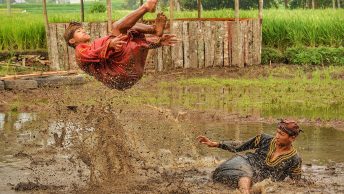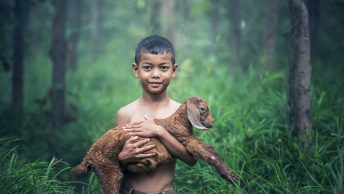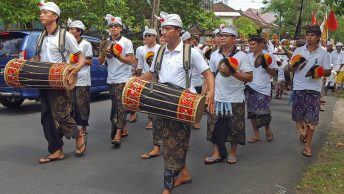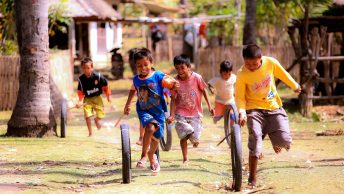The fearsome Komodo dragons measure four meters from snout to tail tip, and weigh 150 kilograms. They can smell prey from several kilometers away and the blow from the tail can kill. Since the days of the dinosaurs, the bloodthirsty lizards have ruled the small, grassy volcanic islands of Rinca and Komodo in southeastern Indonesia.
Slowly, the mighty, green-clad mountains of Rinca come into view in the grey-black horizon. The rain pours unrelentingly, while we quietly slip into the jetty at Loh Buaya, the Ministry of Nature Conservation’s control station, and headquarters for the fearless lizard guardians -jagawanas- in the 196 square kilometer Rinca National Park.
Prohibition for menstruating women
On the pier stands Markus Madu, the head of the national park. Together with him and Daffit Hau, the national park’s most skilled guide, we will track down and research the Komodo lizards – Varanus Komodoensis – a fearsome survival from the days of the dinosaurs.
Early the next morning, we set off into the wilderness. Daffit cuts his way through the thick grass that now stretches us to our waists.
Varans are omnivores, says Daffit, while we carefully let our eyes slide over the landscape. They eat bird eggs and small rodents, deer, water buffalo and carrion. With their long forked tongue, they can smell blood or a carcass from several kilometers away. That is why we have banned menstruating women from visiting the national park. After several hours of marching, we stop at a forest clearing. Daffit has spotted a large lizard lurking in the tall grass.
Dangerous animals
During the rainy season, the monitor lizards are difficult to track down, says Daffit. The tall grass impedes visibility, and the rain forces the alternately heated varanos to remain still. But the monitor lizard Daffit seems unaffected by the rain that is pouring down. In a flash, it disappears into the thicket in front of us.
The lizards on Rinca are somewhat smaller than their relatives on Komodo, says Daffit, as he tries to lure the predatory lizard out of its hiding place. The largest measures four meters and weighs 150 kilograms. They run as fast as humans and can be dangerous. The claws are razor sharp, and the five centimeter long teeth tear the prey to shreds. Even the saliva is so poisonous that a small injury can be fatal.
Suddenly, we see a raptor in the grass in front of us. It is a young animal of around two and a half metres. We sneak in silently. Daffit follows us anxiously with his gaze as we approach the around 80-kilogram slumbering monitor lizard. He still remembers with horror the four-year-old boy who was eaten in the neighboring village of Kampung Rinca three months ago, and the honey anchor from Loh Karora who had his leg locked in the jaws of a waiting waran. the 42-year-old honey anchor managed to scare away the predatory lizard, but the leg had to be amputated.
Fabulous sense of smell
I stop three meters from the lizard, squat down, and take a few quick photos, but then the predatory lizard wakes up. Lightning fast, it throws itself towards Iris, who is standing 10 meters away. Iris runs for her life, before the lizard gives up and disappears into the undergrowth. That evening, the atmosphere is high in the camp, and Markus and Daffit cheerfully talk about previous encounters with the large predatory lizards on Rinca and the neighboring island of Komodo.
The monitor lizards are called Varanus Komodoensis in Latin, says Markus. There are two types. One is the Komodo dragon and the other is the rincavaran. The latter are smaller and slimmer than the Komodo lizards, but faster. Here on Rinca there are around 750 individuals, on Padar around 20 and on Komodo around 1600. There are also a few individuals to the east and north of Flores, but with the exception of Rinca the population is decreasing.
Markus says that Varanus Komodoensis is actually a giant lizard that has existed for millions of years. The oldest discoveries of the predatory lizard have been made in northern Australia, where paleontologists found 110 million-year-old fossils of the lizard’s ancestors.
Due to the strong currents in the Lombok Strait, the Alas Strait and the Sapes Strait, the lizards on Rinca and Komodo were allowed to live in peace until the present day, says Markus. However, mammals and other contemporary carnivores that emerged after the age of the dinosaurs wiped out their relatives in Australia and Asia.
Markus says the monitor lizards hunt at night. Their fabulous sense of smell can track down a carcass or prey from several kilometers away, but their hearing and vision are poor. therefore people are sometimes also attacked. During the day, monitor lizards like to lie in the sun, but at night they crawl out of their burrows and travel long distances in search of food.
The creatures live in caves
The next night, we join 34-year-old Dju to follow a varan that has laid eggs. Dju fled the violence in East Timor in 1983, and has since worked as a lizard keeper on both Rinca and Komodo. He sits inside with a great deal of knowledge about the life of the varans.
The birds of prey live in caves in the same way as small rodents, snakes and ground cuckoos, says Dju, while we struggle along the bottom of a dry river bed. Varans become reproductively capable at the age of six, and lay 15 to 30 eggs at a time. The eggs, which weigh around 105 grams, are laid in special burrows that female monitor lizards dig out. After nine months without incubation, the eggs are hatched by the heat of the earth, and the 25- to 30 centimeter long baby monitor lizards crawl out of the cave in search of food.
10 months after hatching, the lizard measures around 1.1 meters and after 20 months a whopping 1.7 metres, says Dju. Then it is a dangerous predator. A commodity can live for 50 years.
We have arrived at the place Dju wants to show us. A five by ten meter mound of earth the size of an oil drum. A female creature lives here, says Dju. It is two in the morning and it is pitch black around us. The jungle is full of sounds. For two hours, we sit and wait. Then the ground crunches beneath us. Carefully, we place ourselves in position. A forked tongue appears in the light from the lantern, followed by two green eyes. slowly, the lizard lifts the earth-covered snout from the hole. It is a large female, over a meter long.
Girl child eaten alive
The monitor quickly emerges from the cave and heads for the jungle and the rich hunting grounds where deer, water buffalo, tapirs and wild boar live. We run after him, but the monitor gets angry and attacks Dju. But Dju is experienced. He points the forked stick, which is the lizard keepers’ only weapon, at the monitor lizard, and pushes its head away from where he stands.
But the thing won’t stop. it presses on. Dju quickly changes tactics, hits the monitor on the snout, jumps to the side and pushes the monitor into the thicket in front of him. The emergency maneuver is successful, and the lizard disappears, hissing into the dark night.
Every single year, people are injured by the monitor lizards, says Dju, but emphasizes that the horror stories about drooling giant lizards with glowing eyes and ten centimeter long fangs are exaggerated. Most injuries to people result from misunderstandings or provocation. The monitor lizard also has a territory to defend.
Dju still talks about hungry and aggressive monitor lizards that prey on the villages along the coast. they steal eggs, kill chickens and pigs and can attack children. Dju becomes devout when he tells about the three-year-old girl who was torn in half while her mother desperately tried to pull her out of the gap of a four-metre long pole.
The raptor attacks
The night is slowly slipping by today, and we are approaching one of the varan’s many hunting areas. An open plain with tamarind and bidara trees. A wild boar mother with four piglets disappears into the ankle-high grass, and we see the morning’s first hunter. A large male of almost four meters comes running towards us. We spread out in a fan formation, and the varan stops. Then it takes aim at me, and lunges forward. I have clearly encroached on its territory. Dju howls and tells me to run away, but I stay to take photographs.
When the monitor is five meters away from me, I start running backwards while taking pictures. Iris comes running from behind the varan. She wants a picture of me in close contact with the huge predatory lizard.
Dju points and shouts. I turn around. A fallen tree is blocking the escape route. The creature is only three meters from me. I’m at a loss. The item quickly gets closer. At the last second, I throw myself to the side, and the hissing raptor angrily disappears into the undergrowth. Tired but satisfied, we return to the headquarters in Loh Buaya, where Markus, Daffit, Gusti, Kifli and the other lizard keepers are waiting with freshly caught carp and cooked rice. We eagerly tell about our experiences, while a small item of barely a meter circles around the table. It is called selamat tidur, or good night, and is the camp’s pet.
I give selamat tidur some carp, which he nibbles like a dog. Good Night shakes its head and blinks before disappearing into the scrub behind the camp. In two years’ time, God Natt will not be a small house-warming creature, but a feared vulture on the hunt.
Facts Komodo and Rinca
The journey: To get to Rinca and Komodo, you first fly to, for example, Bali. You can find prices there at, for example, www.google.no/flights. It is common to stop in Bangkok, Singapore or Kuala Lumpur. But other places can also be stopped. Then you can fly to Labuan Bajo or Bima, for example. And then take a minibus or boat, depending on where you are flying to.
Lizard spotting: Komodo was for many years the favorite of lizard spotters, but fell in popularity in 1995 when they stopped feeding in Banu Nggulung, a dried-up river bed an hour’s walk northeast of the headquarters. Today, PHPA’s -Ministry of Nature Conservation’s – overnight camp in Loh Buaya at Rinca is recommended.
Climate: Komodo and Rinca are only eight degrees from the Equator and it is warm all year round. The best time to see Komodo dragons is during the dry season from April to September. During the rainy season, the reptiles often stay hidden in caves and under thick vegetation.
Visa and vaccinations: No visa requirement for many countries. No vaccinations are required, but malaria does occur. Start with chloroquine phosphate a week before departure if you are afraid of this.
Board and lodging: There are several accommodations in the surrounding areas and you can also spend the night on a boat, for example, outside the islands (organized from Labuan Bajo and Bima).
Photo credit: https://pixabay.com/photos/komodo-dragon-reptile-lizard-4144830/
July 27, 2024
The last dinosaurs on Komodo







